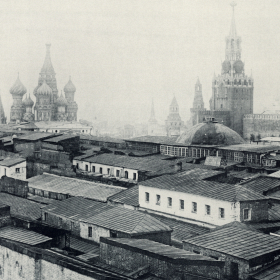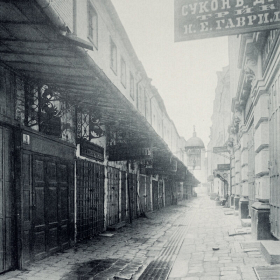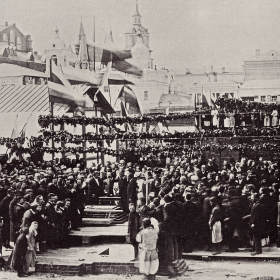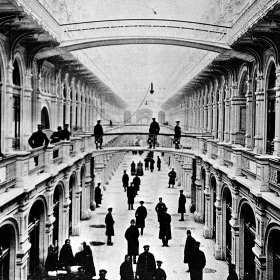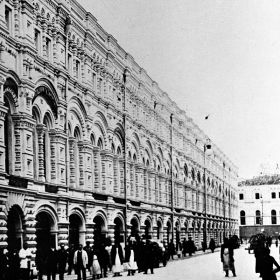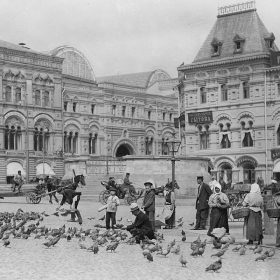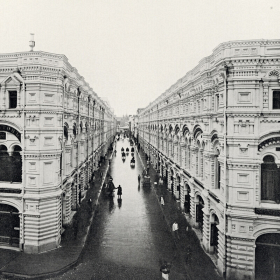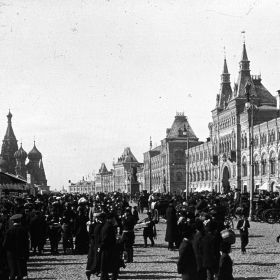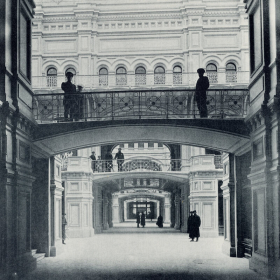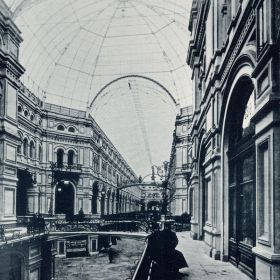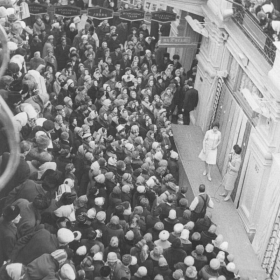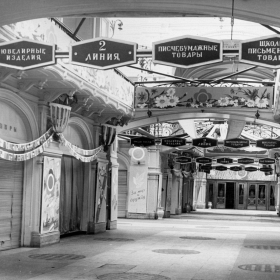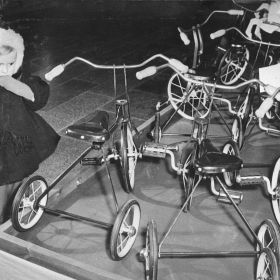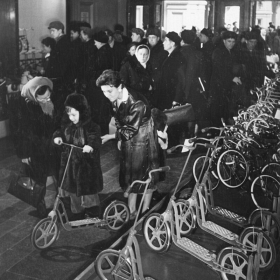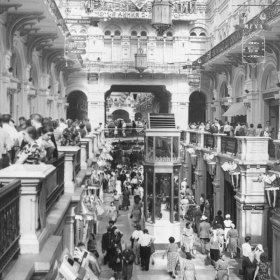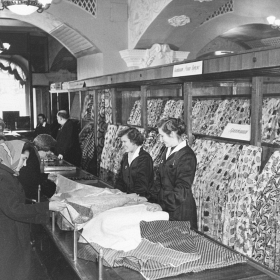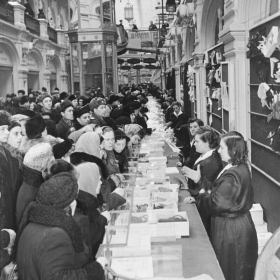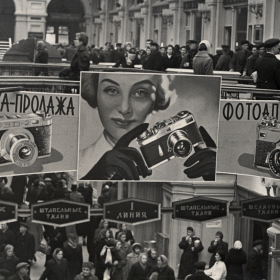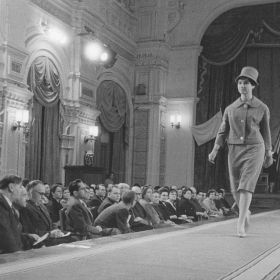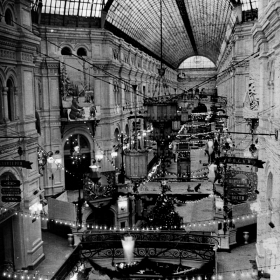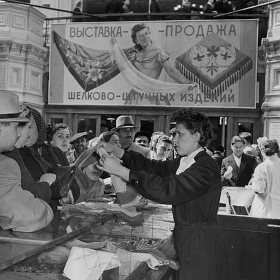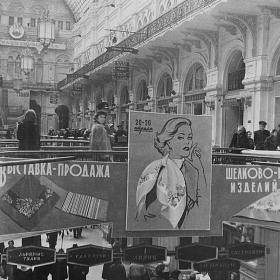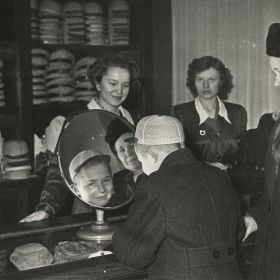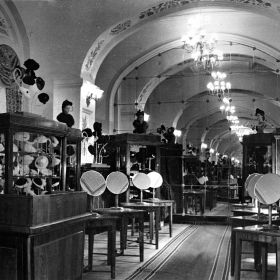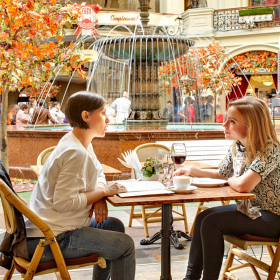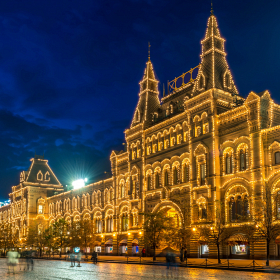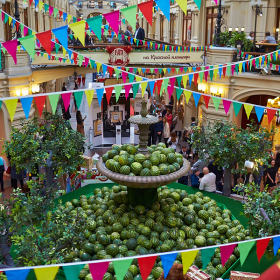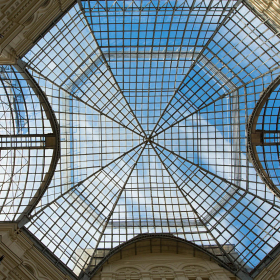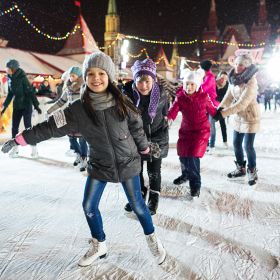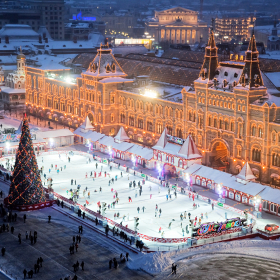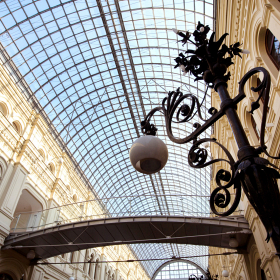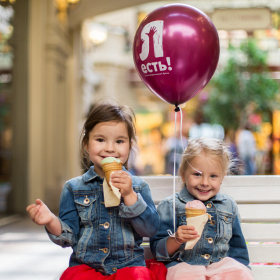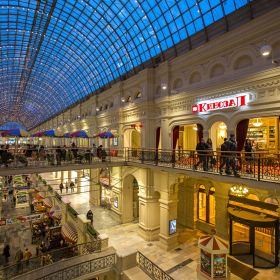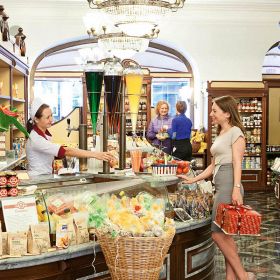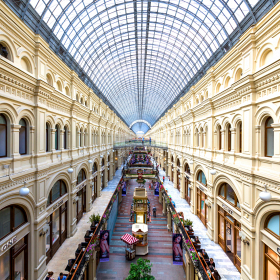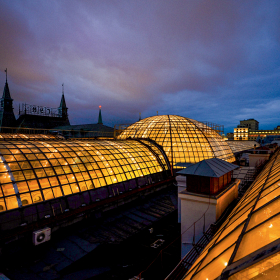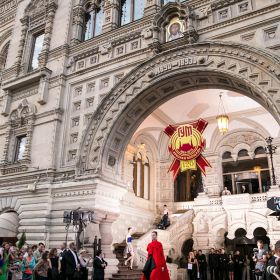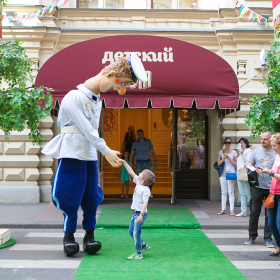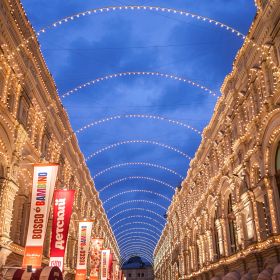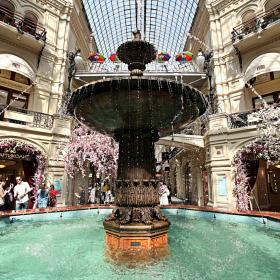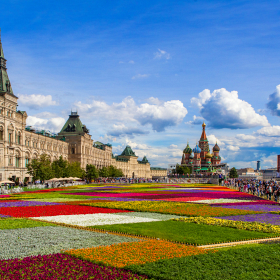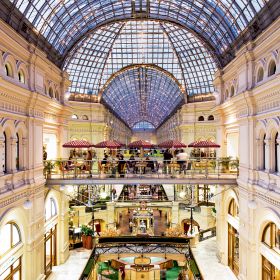XIX century
The Upper Trading Rows were opened on December 2nd 1893. Exceptional for Moscow and Russia project became the largest passage in Europe at the time. Passages - covered shopping streets – were invented at the beginning of the XIX century in Paris after the Napoleonic wars, inspired by the covered bazaars of the Arab Countries.
The oldest one, Passage du Caire, was built in 1799. But these were just covered shopping streets which became stores in the second half of the century. GUM’s closest analogue is Galleria Vittorio Emanuele II in Milan (1877), but the Moscow’s passage is half as much. Also the passage in Milan has no stores at the upper levels
due to the lack of bridges, which GUM is proud of.
The Upper Trading Rows were deliberately created as a symbol of the New Moscow.
They were built in the traditional Moscow market place featuring endless shops of various sizes and ranks.
Although classic facade designed by Osip Bove faced the Red Square,
the Rows were vividly reminiscent of the Grand Bazaar in Istanbul or Damascus inside.
After the reforms carried out by Alexander II, Moscow was the place of proud Russian merchants,
oddly combining fervent conservatism in the spirit of "autocracy, orthodoxy & nationality" and openness
to technical progress and new ideas of capitalism. The new Rows should have become the
most fashionable and technologically advanced European department store in "Russian style".
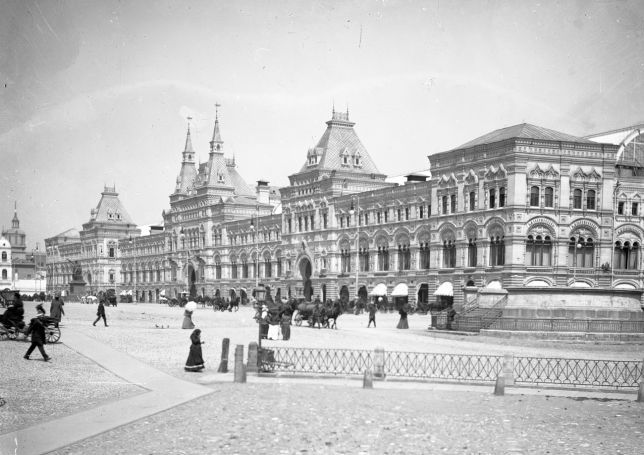
A competition for the project of the Trading Rows held in February 1889 was won by Alexander Pomerantsev.
Roman Klein, who got the second place, built the Middle Trading Rows later. It sounds fantastic now,
but just in 4 years - after the condemnation of the old rows, after the archaeological dig and findings’
handling to the Historical Museum - the Rows have been opened. With full finish, with Vladimir Shukhov’s
glass heaven, with its own power plant & artesian well, with wholesale trade in the basement, with the
offices of telegraph & bank, restaurants, hairdressers, exhibition halls & studios but without its own doors.
According to the original project of Alexander Pomerantsev, the Upper Trading Rows represented
16 large individual buildings with glazed streets between them. It was a city, a perfect city of
Russian merchant capitalism offering silk and brocade fabrics from Sapozhnikov brothers
(6 Grand Prix at the World Exhibition), Mikhail Kalashnikov watches (Leo Tolstoy & Pyotr Tchaikovsky
bought Patek Philippe watches in his shop), pastry of Abrikosovs (suppliers of the Imperial Court
with the right to print the national emblem on the boxes), Brocard perfumery
(another supplier of the Imperial Court as well as the official supplier of the Spanish royal court),
and so on. However, the upper levels & lines featured cheaper products and huge two-level basement,
illuminated through the glass lights in the floor, was used for the wholesale trade.
XX century
In 1917, the trade was terminated and goods were confiscated.
People's Food Commissariat of Alexander Tsiuriupa, which carried out the policy of "food dictatorship”,
was located here. The Rows also hosted the warehouse of requisitioned items and Soviet workers’ dining-room.
"In 1922, Vladimir Lenin decided that ""war communism"" policy would not let the Communists
to be in power and proclaimed the idea of a ""long-term coexistence of capitalism and communism"".
He began to restore diplomatic relations with the West and announced the NEP - ""New Economic Policy"".
But he decided to start from the Upper Trading Rows and signed the ""Regulations on
the State Department Store (GUM)"" on December 1st, 1921.
We do not feel special taste of this word, it has become customary for us,
and yet it is one of the few words of the 20s that Russian language has since then. It is like RKKA
(Red Army), GUKON (State Horse-Breeding Administration) or Rabkrin (Workers' and Peasants' Inspectorate).
All of them except GUM disappeared as useless. GUM advertising along with Vladimir Mayakovsky a
nd Alexander Rodchenko posters filled Moscow streets. GUM has become a symbol of the New Economic Policy.
"
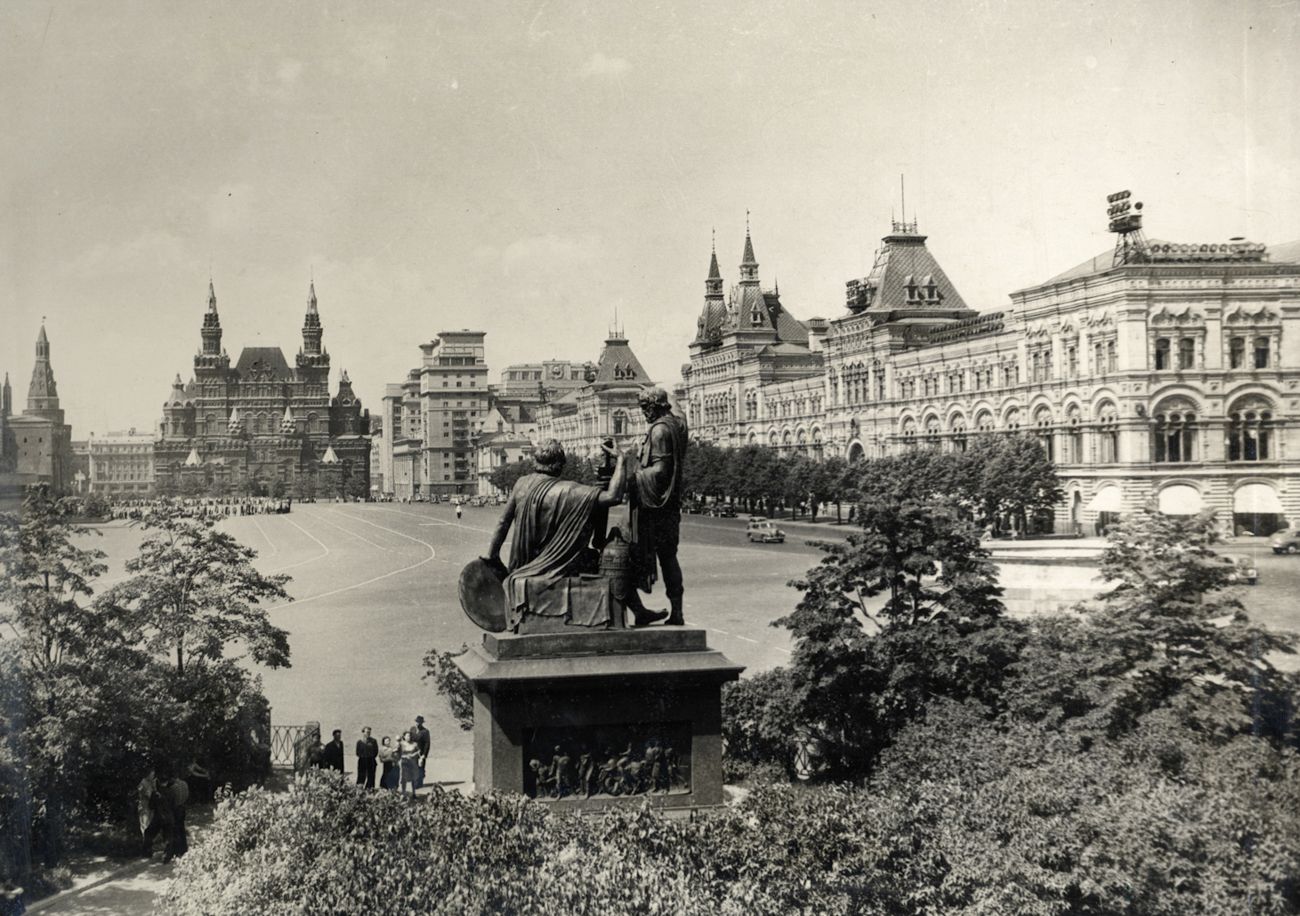
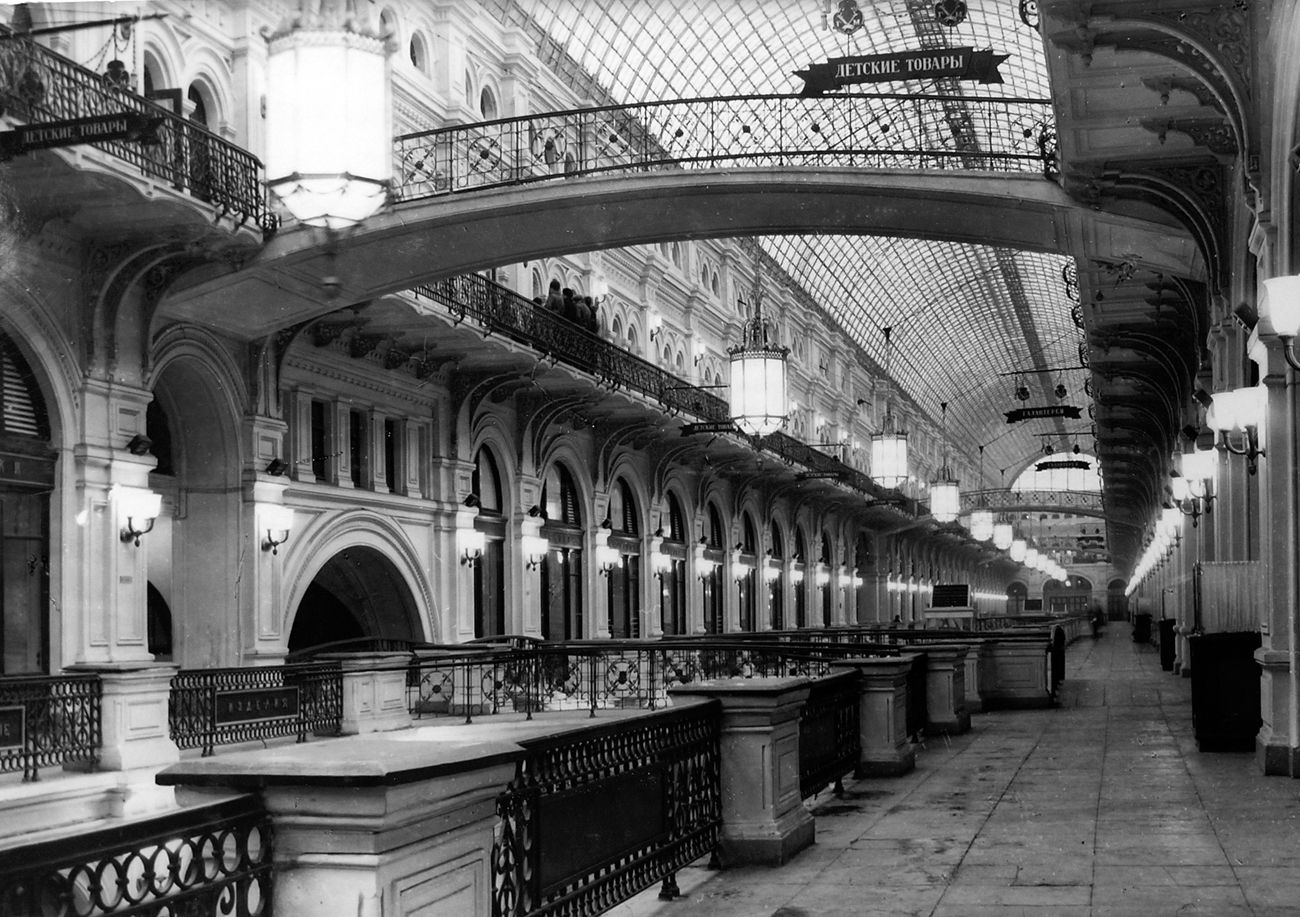
Stalin closed GUM in 1930. Ministries and departments moved here.
The first line was completely closed as Beria's office was located there.
There was a kind of trading. Torgsin (Trade with foreigners shops) & commission shops
selling property of peoples’ enemies worked near the fountain. There also was a grocery
store facing Nikolskaya Street, but in general, GUM ceased to exist. Stalin was going to
demolish it twice (in 1935 and in 1947), government regulations were issued twice, but he did not get round.
Stalin died on March 5th, 1953. His successor Georgi Malenkov declared that
Stalin have commanded to keep peace between the peoples and put forward the idea of
long-term coexistence of the two systems and international tension decreasing.
The military budget was reduced by half, intensive development of agriculture
and light industry was started. It all became known as Khrushchev Thaw later.
But again they decided to try it in GUM first. It was renovated and opened to the
public on December 24th, 1953. Lavrenti Beria was shot on December 23rd.
Newspapers wrote about these events on the identical day. GUM became a symbol of the thaw.
GUM has a unique destiny. It was opened when Russia turned towards people,
common city life and even happiness. Fashion in GUM, demonstration hall, disks &
records in GUM, GUM ice cream are the symbols of Moscow. And it all varnished when the country reversed.
GUM today
"Today GUM lives like it once was conceived.
It is ideal shopping city of Moscow that seems to live without losses and catastrophes for 120 years already.
The fountain in the center of GUM was reopened and pleases visitors since 2007.
This legendary construction is captured in the official chronicles of the twentieth
century and in millions of private shots. They say, the sound of a shutter can be heard
every three seconds here today. The legendary cinema, which went down in the history
of the national movie-making, was restored. Unique illumination project was carried out on the facade.
GUM-Skating rink was opened at Red Square in 2006, which at once gained the fame of
the brightest ice rink of the capital. We have revived the tradition of winter festivities at
Red Square that were popular in Moscow in the XIX century, and added the lightest and happiest
traditions of the XX centuries to them."
"The Gastronome N1, which once was created by Anastas Mikoyan as practical
application to his ""Book of tasty and healthy food"" is reopened in GUM.
Interior design, sellers’ clothing and even the range of some classic Soviet goods
(for example, ""Three elephants"" tea) takes us back to the 50-60s of the last century
although it is the game of course. At bottom, it meets gastronomic caprices of the most
exigent modern consumer. The cafe Festivalnoye and Stolovaya No 57are also made in the
same Soviet style. The cafe is named in honor of the Festival of Youth and Students held
in Moscow in 1957 that brought together 34 000 people from 131 countries.
Drawings & slogans in several languages placed on the walls remind about this event.
The Stolovaya No 57 is classic self-service line.
Mikoyan saw this idea in America in 1936 but could implement it in the Thaw Era only.
However, the food is different here now. It offers good Russian and European cuisine,
but not ""hamburgers"" as Mikoyan used to call it or ""Mikoyan’s patties"" as Soviet people
used to call it in their turn."
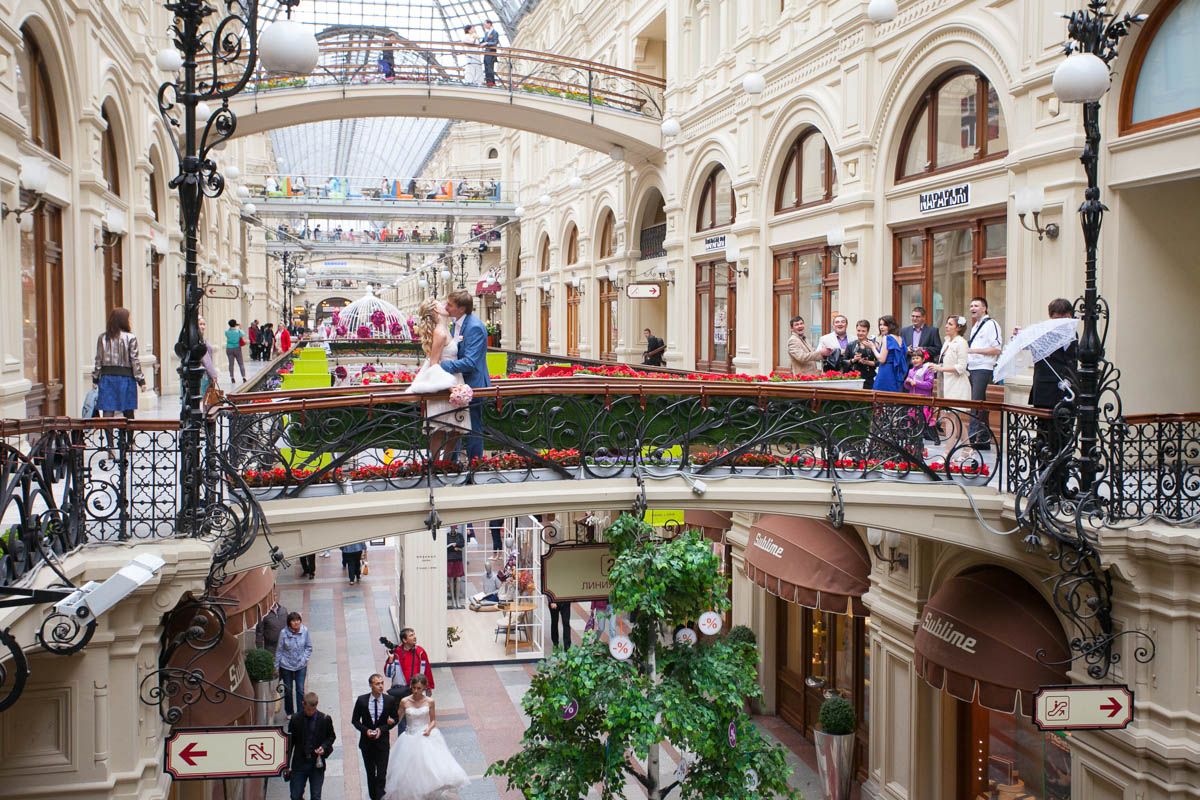
"GUM is not just a store where you can buy almost everything.
It is a shopping block where there is a pharmacy, bank branch, and flower shop ...
It is a monument of architecture. It is a comfortable lounge area with restaurants and cafes.
It is an art gallery and venue for cultural events. It is an integral part of Russian history.
It is a symbol of Moscow and it is the closest place to the Kremlin, where you can feel yourself in Europe."




